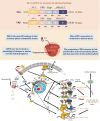Estrogen Receptor Function: Impact on the Human Endometrium
- PMID: 35295981
- PMCID: PMC8920307
- DOI: 10.3389/fendo.2022.827724
Estrogen Receptor Function: Impact on the Human Endometrium
Abstract
The physiological role of estrogen in the female endometrium is well established. On the basis of responses to steroid hormones (progesterone, androgen, and estrogen), the endometrium is considered to have proliferative and secretory phases. Estrogen can act in the endometrium by interacting with estrogen receptors (ERs) to induce mucosal proliferation during the proliferative phase and progesterone receptor (PR) synthesis, which prepare the endometrium for the secretory phase. Mouse knockout studies have shown that ER expression, including ERα, ERβ, and G-protein-coupled estrogen receptor (GPER) in the endometrium is critical for normal menstrual cycles and subsequent pregnancy. Incorrect expression of ERs can produce many diseases that can cause endometriosis, endometrial hyperplasia (EH), and endometrial cancer (EC), which affect numerous women of reproductive age. ERα promotes uterine cell proliferation and is strongly associated with an increased risk of EC, while ERβ has the opposite effects on ERα function. GPER is highly expressed in abnormal EH, but its expression in EC patients is paradoxical. Effective treatments for endometrium-related diseases depend on understanding the physiological function of ERs; however, much less is known about the signaling pathways through which ERs functions in the normal endometrium or in endometrial diseases. Given the important roles of ERs in the endometrium, we reviewed the published literature to elaborate the regulatory role of estrogen and its nuclear and membrane-associated receptors in maintaining the function of endometrium and to provide references for protecting female reproduction. Additionally, the role of drugs such as tamoxifen, raloxifene, fulvestrant and G-15 in the endometrium are also described. Future studies should focus on evaluating new therapeutic strategies that precisely target specific ERs and their related growth factor signaling pathways.
Keywords: G-protein-coupled estrogen receptor; endometrium; estrogen receptor α; estrogen receptor β; human.
Copyright © 2022 Yu, Huang, Xu, Li, Fu and Deng.
Conflict of interest statement
The authors declare that the research was conducted in the absence of any commercial or financial relationships that could be construed as a potential conflict of interest.
Figures




Similar articles
-
The Co-Expression of Estrogen Receptors ERα, ERβ, and GPER in Endometrial Cancer.Int J Mol Sci. 2023 Feb 3;24(3):3009. doi: 10.3390/ijms24033009. Int J Mol Sci. 2023. PMID: 36769338 Free PMC article.
-
GPER and ERα expression in abnormal endometrial proliferations.Rom J Morphol Embryol. 2016;57(2):413-8. Rom J Morphol Embryol. 2016. PMID: 27516013
-
Estrogen receptors as potential therapeutic target in endometrial cancer.J Recept Signal Transduct Res. 2023 Feb;43(1):19-26. doi: 10.1080/10799893.2023.2187643. Epub 2023 Mar 8. J Recept Signal Transduct Res. 2023. PMID: 36883690 Review.
-
Estrogen receptor β: the guardian of the endometrium.Hum Reprod Update. 2015 Mar-Apr;21(2):174-93. doi: 10.1093/humupd/dmu053. Epub 2014 Oct 10. Hum Reprod Update. 2015. PMID: 25305176 Review.
-
Roles of estrogen receptor α and β in the regulation of proliferation in endometrial carcinoma.Pathol Res Pract. 2020 Oct;216(10):153149. doi: 10.1016/j.prp.2020.153149. Epub 2020 Jul 30. Pathol Res Pract. 2020. PMID: 32853964
Cited by
-
Implantation and Decidualization in PCOS: Unraveling the Complexities of Pregnancy.Int J Mol Sci. 2024 Jan 18;25(2):1203. doi: 10.3390/ijms25021203. Int J Mol Sci. 2024. PMID: 38256276 Free PMC article. Review.
-
Increased susceptibility to diet-induced obesity in female mice impairs ovarian steroidogenesis: The role of elevated leptin signalling on nodal activity inhibition in theca cells.Mol Metab. 2025 Jan;91:102062. doi: 10.1016/j.molmet.2024.102062. Epub 2024 Nov 12. Mol Metab. 2025. PMID: 39536822 Free PMC article.
-
Molecular Mechanisms of Tumorgenesis and Metastasis of Long Non-coding RNA (lncRNA) NEAT1 in Human Solid Tumors; An Update.Cell Biochem Biophys. 2024 Jun;82(2):593-607. doi: 10.1007/s12013-024-01287-9. Epub 2024 May 15. Cell Biochem Biophys. 2024. PMID: 38750383 Review.
-
The Role of G Protein-Coupled Estrogen Receptor (GPER) in Vascular Pathology and Physiology.Biomolecules. 2023 Sep 19;13(9):1410. doi: 10.3390/biom13091410. Biomolecules. 2023. PMID: 37759810 Free PMC article. Review.
-
Testosterone and Prolactin Perturbations Possibly Associated with Reduced Levels of β-Arrestin1 in Mononuclear Leukocytes of Women with Premenstrual Dysphoric Disorder.Int J Mol Sci. 2023 Oct 22;24(20):15449. doi: 10.3390/ijms242015449. Int J Mol Sci. 2023. PMID: 37895130 Free PMC article.
References
Publication types
MeSH terms
Substances
LinkOut - more resources
Full Text Sources
Medical
Research Materials

